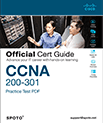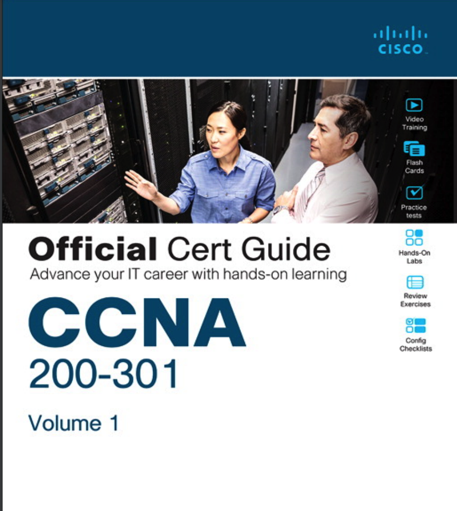SPOTO CCNA 200-301 Bootcamp & Training Courses
2025 Latest Cisco Certified Network Associate (200-301 CCNA) Online Training
- Get what you need to pass the up-to-date Cisco CCNA 200-301 exam
- Gain hands-on Cisco CCNA configuration and troubleshooting experience through practice labs
- Explore how routing and switching technologies work in real world environments
- Develop skills to work on enterprise production networks
What you'll learn
Training Course Outline
Google Cloud Digital Leader Certification
SEQ 1:Network Fundamentals
SEQ1_Sub_01:Network Fundamentals
SEQ 2:IPv4 addressing & IPv6 addressing
SEQ2_Sub_01:IPv4 addressing & IPv6 addressing
SEQ 3:Network Access
SEQ3_Sub_01 Describe switching concepts
SEQ3_Sub_02 Switching Concepts
SEQ3_Sub_03 VLANS
SEQ3_Sub_04 VLANS In a Multi-Switched Environment
SEQ3_Sub_05 VLAN Configuration
SEQ3_Sub_06 VLAN Trunks
SEQ3_Sub_07 DTP Dynamic Trunking Protocol
SEQ3_Sub_08 Exp VLAN Configurations-Trunk Port and Access Ports
SEQ3_Sub_09 STP Concepts
SEQ3_Sub_10 STP Operations
SEQ3_Sub_11 Evolution of STP
SEQ3_Sub_12 STP
SEQ3_Sub_13 Layer Switch Overview
SEQ3_Sub_14 CDP And LLDP
SEQ3_Sub_15 EtherChannel
SEQ3_Sub_16 Exp EtherChannel Using PAgP and LACP
SEQ3_Sub_17 EtherChannel Configuration
SEQ3_Sub_18 Configure EtherChannel
SEQ3_Sub_19 Verify and TroubleShoot EtherChannel
SEQ3_Sub_20 Exp EtherChannle Layer2/3 and Loadbalance
SEQ 4:IP Connectivity
SEQ4_Sub_01 Routing Overview
SEQ4_Sub_02 Routing Concepts
SEQ4_Sub_03 Path Determination
SEQ4_Sub_04 Packet Forwarding
SEQ4_Sub_05 Basic Routing Configuration Review
SEQ4_Sub_06 IP Routing Table
SEQ4_Sub_07 IP Routing Table2
SEQ4_Sub_08 Static and Dynamic Routing
SEQ4_Sub_09 IP Static Routing
SEQ4_Sub_10 Configure IP Static Routes
SEQ4_Sub_11 Configure ip Default Static Routes
SEQ4_Sub_12 Configure Floating Static Routes
SEQ4_Sub_13 Configure Static Host Routes
SEQ4_Sub_14 Exp Configure IPv4 and IPv6 Static and Default Routes
SEQ4_Sub_15 Single-Area OSPFv2 Concepts
SEQ4_Sub_16 OSPF Features and Characteristics
SEQ4_Sub_17 OSPF Packets
SEQ4_Sub_18 OSPF Operation
SEQ4_Sub_19 Exp Single-Area OSPFv2 Configuration
SEQ4_Sub_20 FHRP Concepts
SEQ4_Sub_21 HSRP
SEQ4_Sub_22 NAT For IPv4
SEQ4_Sub_23 NAT Characteristics
SEQ4_Sub_24 Types of NAT
SEQ4_Sub_25 NAT Advantages and Disadvantages
SEQ4_Sub_26 Static NAT
SEQ4_Sub_27 PAT
SEQ4_Sub_28 Exp Static,Pool NAT
SEQ 5:IP Services
SEQ5_Sub_01 DNS and DHCP
SEQ5_Sub_02 Network Management
SEQ5_Sub_03 Device Discovery with LLDP
SEQ5_Sub_04 NTP
SEQ5_Sub_05 SNMP
SEQ5_Sub_06 Syslog
SEQ5_Sub_07 Router and Switch File Maintenance
SEQ5_Sub_08 SNMP
SEQ5_Sub_09 Router and Switch File Maintenance
SEQ5_Sub_10 IOS Image Management
SEQ5_Sub_11 Exp Configuarte Router
SEQ5_Sub_12 DHCPv4
SEQ5_Sub_13 Configure a Cisco IOS DHCPv4 Server
SEQ5_Sub_14 Configure a DHCPV4 Client
SEQ5_Sub_15 Exp: Configuring DHCP on a Cisco Router
SEQ5_Sub_16 Network Security Fundamentals
SEQ5_Sub_17 Networl Attacks
SEQ5_Sub_18 Network Attack Mitigations
SEQ5_Sub_19 Device Security
SEQ5_Sub_20 LAN Security Concepts
ESEQ5_Sub_21 Access Control
ESEQ5_Sub_22 Access Countrol 2
SEQ5_Sub_23 Layer 2 Security Threats
ESEQ5_Sub_24 Mac Address Table Attack
SEQ5_Sub_25 LAN Attack
SEQ 6:Security Fundamentals
SEQ6_Sub_01 Security Configuration
SEQ6_Sub_02 Mac Adress Table Attack
SEQ6_Sub_03 LAN Attacks
SEQ6_Sub_04 Implement Port Security
SEQ6_Sub_05 Mitigate DHCP Attacks
SEQ6_Sub_06 Mitigate Stp Attacks
SEQ6_Sub_07 Mitigate Stp Attacks
SEQ6_Sub_08 Mitigate STP Attacks
SEQ6_Sub_09 Wlan Configuration
SEQ6_Sub_10 Remote Site WLAN Configuration
SEQ6_Sub_11 Configura a Basic WLAN on the wlc
SEQ6_Sub_12 Configuration a WPA2 Enterprise WLAN on the wlc
SEQ6_Sub_13 Troubleshoot WLAN Issues
SEQ6_Sub_14 Network Design
SEQ6_Sub_15 Scalable Networks
SEQ6_Sub_16 Switch Hardware
SEQ6_Sub_17 Router Hardware
SEQ6_Sub_18 WLAN concepts
SEQ6_Sub_19 WLAN components
SEQ6_Sub_20 Secure WLANs
SEQ6_Sub_21 WLAN Encryption
SEQ6_Sub_22 ACL Concepts
SEQ6_Sub_23 Purpose of ACLs
SEQ6_Sub_24 Wildcard Masks in ACLs
SEQ6_Sub_25 Types of ipv4 acls
SEQ6_Sub_26 Configure standard ipv4 acls
SEQ6_Sub_27 Modify ipv4 acls
SEQ6_Sub_28 Secure VTY Ports...ndard ipv4 ACL
SEQ6_Sub_29 ipv6 ACLs
SEQ6_Sub_30 VPN and IPsec concepts
SEQ6_Sub_31 IPsec
SEQ6_Sub_32 Network programming
SEQ6_Sub_33 Cloud Computing
SEQ6_Sub_34 Virtualization
SEQ6_Sub_35 Virtual Network Infrastructure
SEQ6_Sub_36 Software-Defined Networking
SEQ6_Sub_37 CONTROLLERS
SEQ6_Sub_38 ACI
SEQ6_Sub_39 Network Automation
SEQ6_Sub_40 Data Formats
SEQ6_Sub_41 APIs
SEQ6_Sub_42 IBN and Cisco DNA Center
Training Options
Self Paced Learning
- Lifelong access to high-quality content
- Curated by industry experts
- Customized learning progress
- 24/7 learner assistance and support
- Follow the latest technology trends
Exam Dump
- 100% Real Exam Practice Tests
- 100% Verified Exam Questions & Answers
- 100% Guarantee Passing Rate
- Average 7 Days to Practice & Pass
Description
Level up your career in IT with this video-based online training course designed to help you master foundational networking skills and succeed on the CCNA 200-301 exam.The CCNA prep course provides hands-on training with core topics such as networking technologies, IPv4 and IPv6 addressing, Ethernet switching, routing, wireless networks, network services, and network programmability.
Pre-requisites
Absolute beginners to networking are welcome. Start with beginner level networking and explain every single acronym and concept you need to pass the exam.

CCNA 200-301 Practice Test PDF
SPOTO Free CCNA 200-301 Practice Test PDF. 100% Valid CCNA Exam Questions and Answers from Real Exam.

CCNA Exam v1.0 (200-301) Exam Topics
This ebook mainly introduces the general guidelines for the content likely to be included on the ccna 200-301 exam.

CCNA 200-301 Official Cert Guide Library
CCNA 200-301 Official Cert Guide Library is a comprehensive review and practice package for the latest CCNA exam and is the only self-study resource approved by Cisco.
CCNA Exam & Certification
Network Fundamentals in CCNA
Network Fundamentals form the backbone of the CCNA certification, covering essential concepts like the OSI and TCP/IP models, IPv4/IPv6 addressing, subnetting (VLSM/CIDR), and basic network protocols (ARP, ICMP). Candidates learn to differentiate between LAN, WAN, and cloud infrastructures and understand data encapsulation/decapsulation processes. Key topics include Ethernet standards, cabling types, and network topologies. Mastery of these principles enables professionals to design and troubleshoot foundational network architectures, ensuring efficient data flow and connectivity.
Network Access in CCNA
This domain focuses on configuring and managing network access technologies, including VLANs, trunking (802.1Q), and Layer 2 protocols like STP/RSTP. Candidates learn to deploy switches, configure port security, and implement EtherChannel for link aggregation. Wireless networking basics, such as SSID configuration and authentication methods (WPA2/WPA3), are also covered. Hands-on labs emphasize troubleshooting VLAN misconfigurations and optimizing network performance, ensuring seamless connectivity in wired and wireless environments.
IP Connectivity in CCNA
IP Connectivity addresses routing protocols and IPv6 deployment. Candidates master static routing, OSPF (single/multi-area), and EIGRP configurations, alongside route redistribution and path selection. IPv6 concepts include address types (global unicast, link-local) and static routing implementation. Troubleshooting scenarios focus on resolving routing loops, OSPF neighbor adjacency issues, and IPv6 connectivity gaps. This domain ensures proficiency in building scalable, interoperable networks.
IP Services in CCNA
IP Services encompass DHCP, NAT, ACLs, and QoS. Candidates configure DHCP servers, relay agents, and NAT pools (static/dynamic) to manage IP allocation and address translation. ACLs are implemented for traffic filtering, while QoS tools prioritize critical applications. Additional topics include NTP for time synchronization and SNMP for network monitoring. Practical labs reinforce skills in optimizing service delivery and mitigating bottlenecks.
Network Security Fundamentals in CCNA
Security modules emphasize threat mitigation via ACLs, port security, and VPN technologies (IPsec, SSL). Candidates configure AAA (Authentication, Authorization, Accounting) using RADIUS/TACACS+ and implement Layer 2 protections (DHCP snooping, dynamic ARP inspection). Security best practices, such as role-based access control (RBAC) and compliance frameworks (GDPR), are integrated into network designs. Labs simulate real-world attacks, training professionals to harden networks against breaches.
Network Automation and Programmability in CCNA
This emerging domain introduces automation tools (Ansible, Python scripts) and SDN concepts. Candidates learn to automate repetitive tasks using APIs (REST, NETCONF) and manage devices via Cisco DNA Center. Programmability topics include JSON/XML data formats and model-driven telemetry. Practical exercises focus on deploying configurations at scale, reducing human error, and enhancing operational efficiency in hybrid cloud environments.